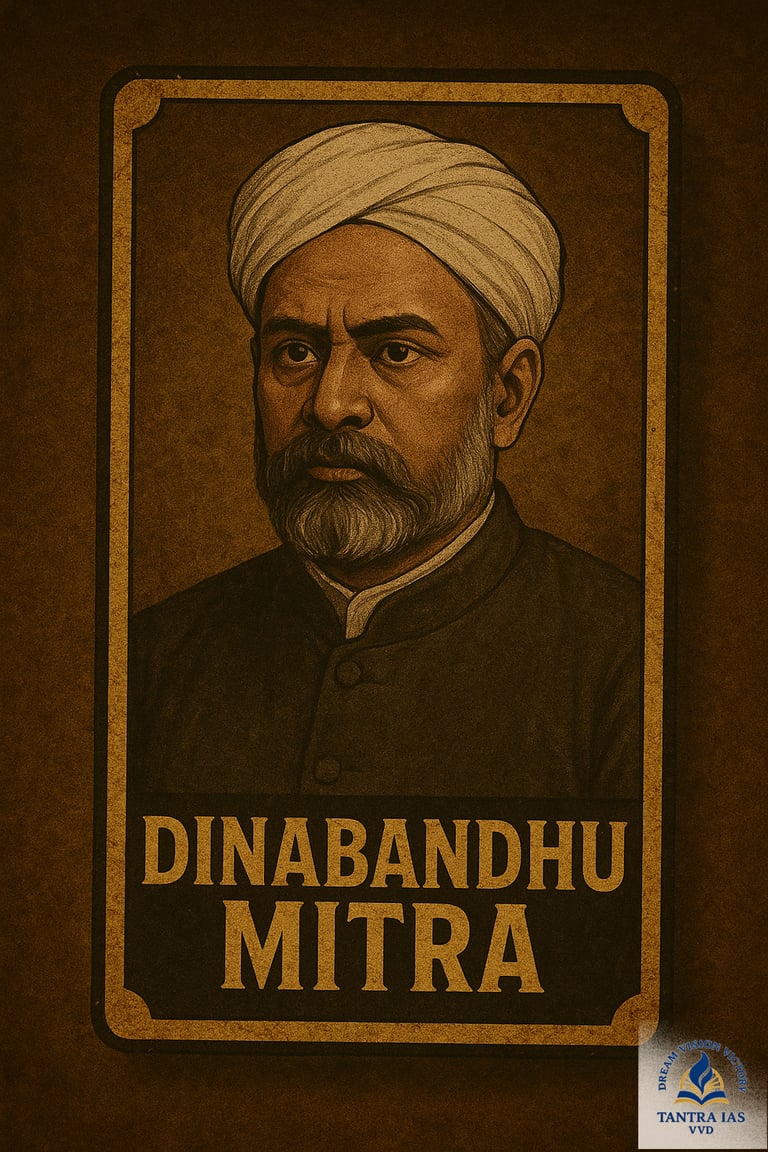

DINABANDHU MITRA
1) Context / About:
Dinabandhu Mitra (1830–1873) was a Bengali dramatist and social critic.
Best known for exposing colonial oppression through his path-breaking play “Nil Darpan” (1860).
2) UPSC Syllabus Mapping:
Prelims: Modern Indian history; Indigo Revolt; literary contributions.
GS1: Socio-cultural awakening; role of literature in social reform & nationalism.
3) Prelims — High-Yield One-Liners:
Occupation: Postal employee → playwright.
Landmark work: Nil Darpan, based on the exploitation of indigo peasants.
Published first in Bengali, translated by Rev. James Long → resulted in the famous “Long Trial”.
Nil Darpan directly referenced the Indigo Revolt of 1859–60.
Patron circles: associated with early Bengali intelligentsia.
Themes: colonial brutality, peasant suffering, moral resistance.
UPSC Prelims 2025 Pattern — MCQ :
Q. With reference to Dinabandhu Mitra, consider the following statements:
He authored the play Nil Darpan, which depicted the Indigo Revolt.
The English translation of his play led to a high-profile court case under British rule.
He was associated with the early social reform movements in Bengal.
Nil Darpan was written after the Non-Cooperation Movement.
How many of the above statements are correct?
(a) Only one
(b) Only two
(c) Only three
(d) All four
✅ Answer: (c)
Correct → 1, 2, 3
Incorrect → 4 (Nil Darpan predates 1857–60 era, not post-1920.)
4) Mains Relevance (GS1):
Answer Structure
Intro: Dinabandhu Mitra used literature as an early weapon against colonial injustice.
Body:
Nil Darpan amplified peasant voices during the Indigo Revolt.
Marked the rise of politically charged Bengali theatre.
Exposed planter atrocities → embarrassed colonial administration.
Shaped public opinion and reform discourse in Bengal.
Conclusion: His work prefigured the later nationalist use of literature as resistance.
5) Value Addition:
“Long Trial” became a watershed moment in colonial press regulation history.
Supported by intellectuals like Michael Madhusudan Dutt.
Helped lay the foundation for realist social drama in India.
Probable GS1 Question (2026):
Q. “Evaluate the role of Dinabandhu Mitra’s Nil Darpan in shaping early resistance against colonial exploitation.”
Tantra IAS Takeaway:
Before politics found its voice,
literature spoke for India.
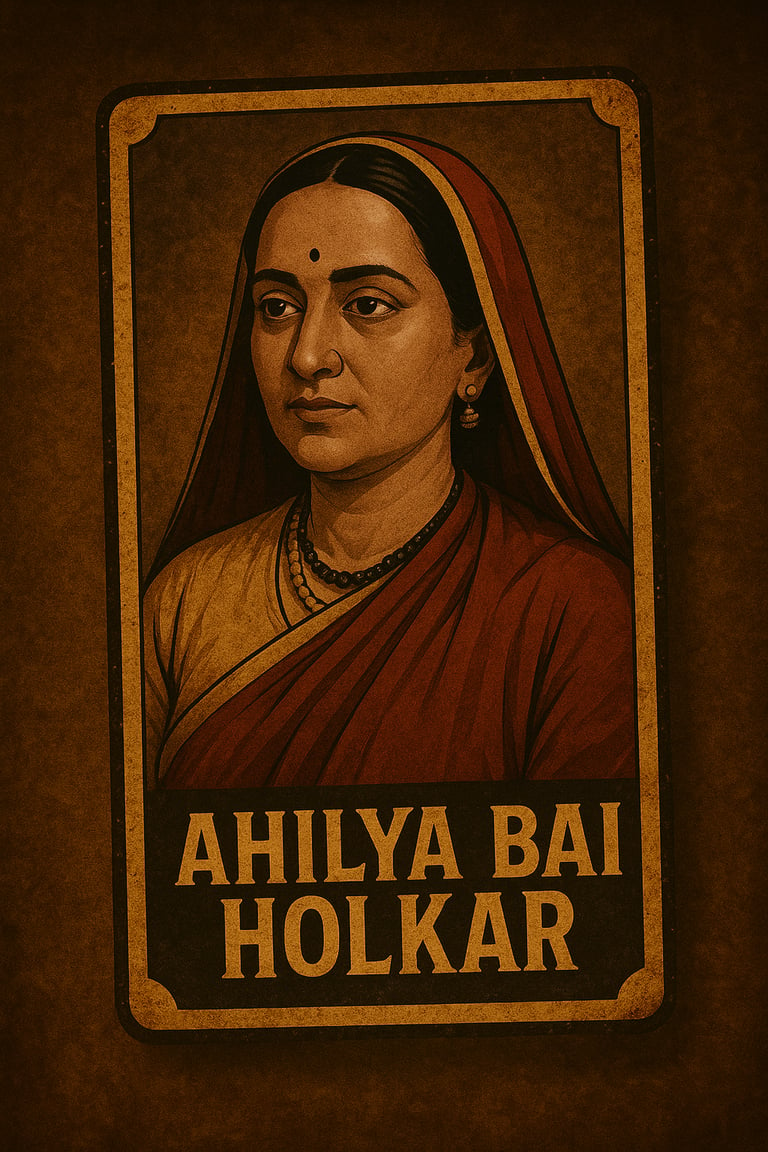

AHILYA BAI GHAT (VARANASI)
1) Context / About:
Ahilya Bai Ghat in Varanasi is named after Ahilya Bai Holkar, one of India’s greatest temple-builders.
Built in the 18th century, reflecting her vision for sacred, accessible Ghats.
Known for its clean steps, courtyards, shrines, and carved temple structures.
2) UPSC Syllabus Mapping:
Prelims: Indian culture — architecture, temple tradition, Ghats of Varanasi.
GS1: Contributions of women leaders; cultural heritage; urban sacred spaces.
3) Prelims — High-Yield One-Liners:
Patron: Ahilya Bai Holkar, Holkar Dynasty.
Era: 18th century (Maratha period).
Contribution: Restored Kashi Vishwanath Temple, built/renovated dozens of Ghats and shrines across India.
Significance: Shows Maratha-era temple patronage beyond Deccan.
Style: Simple, functional architecture with devotional purpose.
Location: On the banks of Ganga, Varanasi.
UPSC Prelims 2025 Pattern — MCQ :
Q. With reference to Ahilya Bai Ghat in Varanasi, consider the following statements:
It was constructed during the 18th century under Ahilya Bai Holkar’s patronage.
It is one of the Ghats associated with Maratha architectural influence in Varanasi.
Ahilya Bai Holkar is known for restoring several temples across India, including Kashi Vishwanath.
The Ghat is primarily a medieval construction dating before the Mughal period.
How many of the above statements are correct?
(a) Only one
(b) Only two
(c) Only three
(d) All four
✅ Answer: (c)
Correct → 1, 2, 3
Incorrect → 4 (It is not medieval; it is 18th-century Maratha era.)
4) Mains Relevance (GS1):
Answer Structure:
Intro: Ahilya Bai Holkar transformed Varanasi’s sacred landscape through her temple-building patronage.
Body:
Consolidated Maratha influence in Kashi’s spiritual architecture.
Promoted public utility, cleanliness, and accessibility in ghat design.
Her work preserved Hindu religious sites during a period of cultural-political transition.
Conclusion: Ahilya Bai’s legacy stands as a rare example of women-led cultural stewardship.
Value Addition:
She renovated shrines at Somnath, Gaya, Ayodhya, Rameshwaram and more.
Referred to as the “Architect of Modern Kashi” for her impact.
Her contributions strengthened pilgrimage networks across India.
Probable GS1 Question (2026):
Q. “Evaluate the role of Ahilya Bai Holkar in preserving and reconstructing India’s sacred geographies.”
5) Current Relevance:
Varanasi’s ghats are frequently featured in cultural conservation initiatives.
Ahilya Bai’s work is often cited as a model for heritage-led urban renewal.
6) Tantra IAS Takeaway
Some rulers expanded territories.
Ahilya Bai expanded civilisation.


RANI LAKSHMIBAI
1) Context / About
19 November 1828 marks the birth anniversary of Rani Lakshmibai, a central figure in the 1857 Revolt.
Symbol of resistance to British annexation under Doctrine of Lapse.
Led Jhansi’s defense against British forces in 1857–58.
2) UPSC Syllabus Mapping:
Prelims: Modern Indian History – revolt of 1857, personalities, policies.
GS1: Role of women in freedom struggle; 1857 causes & consequences.
3) Prelims — High-Yield One-Liners:
Birth: Varanasi (1828); childhood name: Manikarnika Tambe.
Married to: Gangadhar Rao, ruler of Jhansi.
Conflict trigger: British rejection of her adopted son under Doctrine of Lapse.
Key battles: Jhansi, Khanpur, Kalpi, Gwalior.
Associates: Tatya Tope, Rao Saheb, Dundhu Panth.
Died: Gwalior, June 1858 while resisting British advance.
Symbol of: women-led armed resistance in colonial India.
UPSC Prelims 2025 Pattern — Sample MCQ:
Q. With reference to Rani Lakshmibai, consider the following statements:
She opposed the British attempt to annex Jhansi under the Doctrine of Lapse.
She led the final phase of resistance in Gwalior during the 1857 uprising.
She was a member of the Nana Saheb-led court at Kanpur before joining the revolt.
She was killed while defending the Red Fort at Delhi.
How many of the above statements are correct?
(a) Only one
(b) Only two
(c) Only three
(d) All four
✅ Answer: (b)
Correct: 1 and 2
Incorrect:
3 → She was NOT part of Nana Saheb’s court.
4 → She died near Gwalior, not Delhi.
4) Mains Relevance (GS1):
Answer Structure
Intro: Rani Lakshmibai embodies grassroots resistance to colonial expansion.
Body:
Doctrine of Lapse → political grievance catalyst.
Led Jhansi’s defense with unprecedented leadership.
Mobilised local armies & collaborated with Tatya Tope.
Participation of women → critical dimension of 1857’s social reach.
Conclusion: Her role symbolises the moral-emotional core of early nationalism.
Value Addition:
1857 described as “National Rising with local limitations” (R.C. Majumdar vs. S.N. Sen).
British recorded her as “the most dangerous leader of the rebels” (General Hugh Rose).
Probable GS1 Mains 2026 Question:
Q. “Evaluate the role of Rani Lakshmibai in the Revolt of 1857, highlighting how her leadership shaped the social and regional dimensions of the uprising.”
5) Current Relevance:
Her legacy linked to gender empowerment narratives.
Referenced in cultural schemes, commemorative events, and patriotic literature.
6) Tantra IAS Takeaway:
History remembers many kings.
It reveres the few who fought for a people — even when the odds were broken.
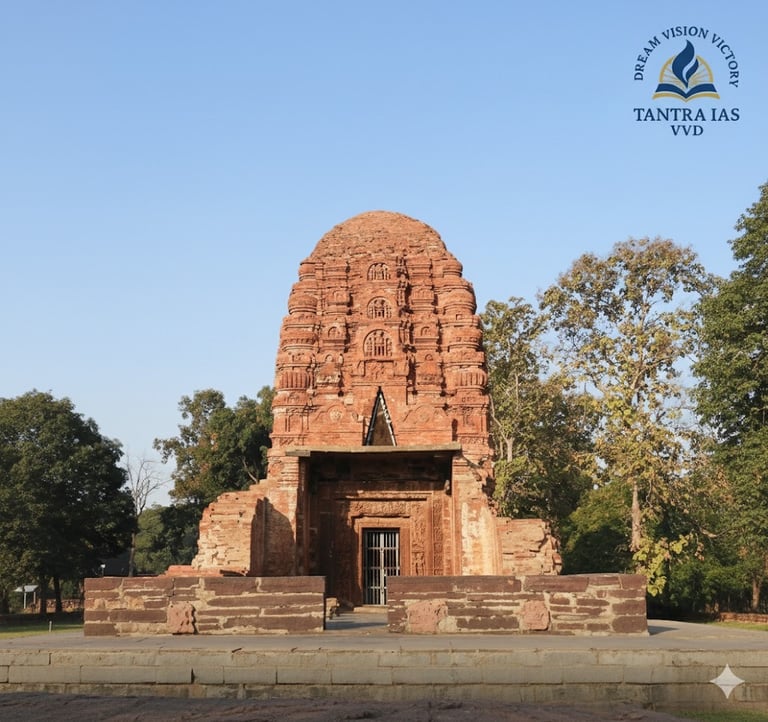

LAKSHMANA TEMPLE, SIRPUR (CHHATTISGARH)
Context / About:
Era: 7th century CE
Builder: Queen Vasata, Panduvamsi dynasty
Deity: Vaikuntha Vishnu (four-faced form)
Location: Sirpur, Mahasamund district, on banks of Mahanadi River
Material: Brick with stone carvings — among earliest surviving brick temples
Style: Early Nagara (Rekha-Deul) architecture
Cultural setting: Coexistence of Hindu and Buddhist structures in the same site
UPSC Syllabus Mapping:
Prelims: Indian Art & Culture → Temple Architecture (Nagara, Dravida, Vesara)
Mains GS-1: Indian Culture → Art Forms, Literature, and Architecture (ancient to modern)
Prelims Relevance:
Built during early medieval period — transition from Gupta to regional styles.
Among earliest brick temples of North India.
Vaikuntha Vishnu image: four faces symbolising cosmic aspects.
Represents Nagara style (curvilinear shikhara, square sanctum).
Sirpur — multi-religious centre (Hindu + Buddhist).
River association: Mahanadi, not Godavari.
ASI protects the site; part of National Heritage list.
Comparative examples: Bhitargaon (UP) and Mukteshwara (Odisha).
UPSC 2025 PATTERN MCQ:
Q. With reference to the Lakshmana Temple at Sirpur, consider the following statements:
It was built by Queen Vasata of the Panduvamsi dynasty and is dedicated to Vaikuntha Vishnu.
It is among the earliest brick temples of India and represents the Nagara style.
Sirpur was a centre of both Hindu and Buddhist faiths during the 7th–8th centuries CE.
The temple is situated on the banks of the Godavari River.
How many of the above statements are correct?
(a) Only one (b) Only two (c) Only three (d) All four
✅ Answer: (c) — Statements 1, 2 and 3 are correct.
Source: ASI Sirpur Monograph (2019); NCERT An Introduction to Indian Art XI.
Mains Relevance (GS-1 Perspective):
Answer Structure (One-Liners):
Intro: Identify as 7th-century brick temple built by Queen Vasata → early phase of Nagara architecture.
Body: (1) Architectural features — brick core, curvilinear shikhara, carved doorframe.
(2) Religious context — Hindu–Buddhist coexistence at Sirpur.
(3) Cultural significance — transition from Gupta classicism to regional style.Conclusion: Shows continuity of sacred form amid regional innovation — a template for later Central Indian architecture.
Value Additions:
ASI Report (2019): One of India’s oldest standing brick temples.
Panduvamsi patronage linked to political stability of Dakshina Kosala.
UNESCO tentative listing proposal under Central Indian Heritage Corridor (2024).
Compare with Bhitargaon (UP) and Mukteshwara (Odisha).
Diagram Suggestion:
Simple labeled sketch showing Nagara Rekha-Deul → vertical shikhara with amalaka + square sanctum base → caption “Early Brick Nagara Form — Sirpur.”
Probable GS-1 Mains 2026 Question:
Q. “Discuss how the Lakshmana Temple at Sirpur reflects the transition from Gupta classicism to regional forms of temple architecture in early medieval India.”
Current Relevance (2024–25):
Featured in Dekho Apna Desh tourism circuit (2024).
Sirpur Heritage Corridor under development by Chhattisgarh Govt.
ASI strengthening preservation due to weathering of brick structure.
Frequently referenced in Cultural Mapping of India by Ministry of Culture.
Tantra IAS Takeaway
UPSC rewards eyes that see beyond stone. The Lakshmana Temple reminds you — endurance, not appearance, defines legacy.
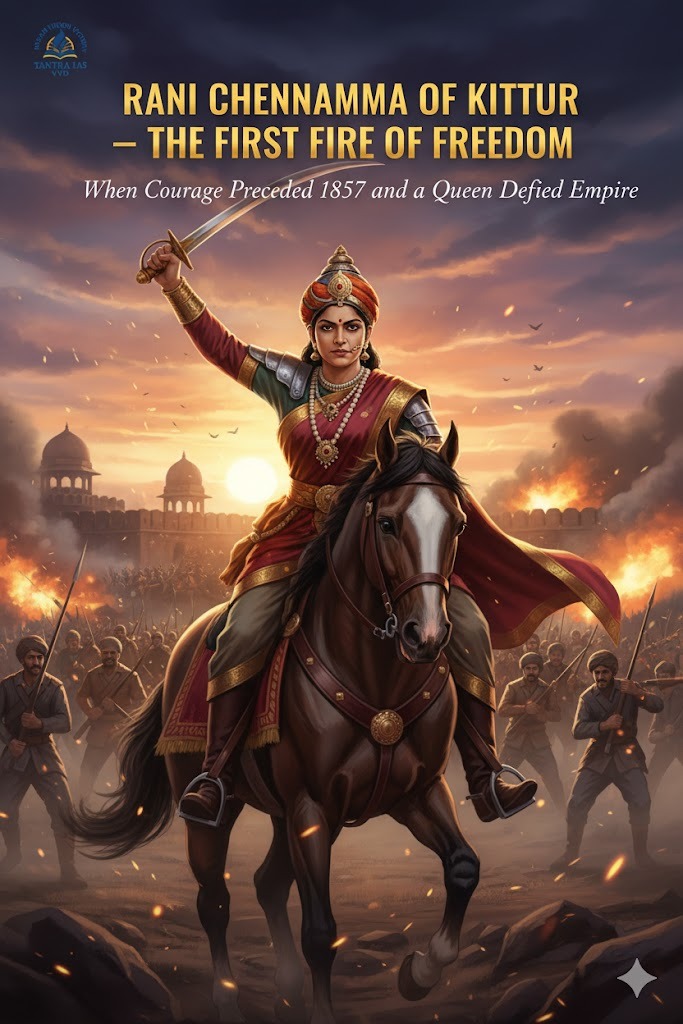

⚔️ “RANI CHENNAMMA OF KITTUR — THE FIRST FIRE OF FREEDOM”
When Courage Preceded 1857 and a Queen Defied Empire
(Tantra IAS Masala Daily | GS1 + Essay + Mindset Edition)
🧭 CONTEXT:
Decades before 1857, when India’s first war of independence was yet to erupt, Rani Chennamma of Kittur (1778–1829) became the first Indian queen to lead an armed rebellion against the British East India Company.
Her revolt of 1824 against the Doctrine of Lapse predated Rani Lakshmibai by more than 30 years, proving that freedom began in the south before it caught fire across the north.
⚙️ UPSC VALUE CHAIN (GS1 + GS4 + Essay Integration):
GS1 – Modern Indian History: Early resistance to British annexation policy; regional revolts before 1857.
GS2 – Governance & Ethics: Leadership grounded in moral authority — rule by righteousness.
GS4 – Integrity & Courage: A case study in moral conviction under crisis.
Essay Paper: “The first flame of freedom was kindled by conscience, not conquest.”
⚔️ TIMELINE OF RESISTANCE:
1824: British attempt to annex Kittur under the Doctrine of Lapse.
Rani Chennamma revolts, defeats British forces initially led by St. John Thackeray.
Later captured and imprisoned at Bailhongal Fort, where she died in 1829 — but the idea of defiance spread across the Deccan.
Legacy: Inspired subsequent resistances in Karnataka and became a symbol of Desh Bhakti for generations.
📊 PRELIMS BOOSTER:
Rani Chennamma: Queen of Kittur (modern Karnataka).
Revolt year: 1824.
Cause: British refusal to recognize adopted heir; Doctrine of Lapse.
Outcome: Temporarily defeated British; later captured.
Other contemporaries: Sangolli Rayanna (her military commander) continued resistance till 1831.
Legacy: First recorded woman-led armed rebellion against the British.
🧩 CURRENT RELEVANCE (2024–25):
Government of India honours her under Azadi Ka Amrit Mahotsav.
Her portrait unveiled in Parliament Central Hall (2024) as part of “Unsung Women of Freedom” initiative.
Kittur Utsav (Karnataka) promoted as national heritage event under Dekho Apna Desh 2.0.
🕊️ TANTRA TAKEAWAY:
“Rani Chennamma didn’t fight for a slogan — she fought for the soul of Bharat.”
Her rebellion defined the moral grammar of India’s freedom struggle — that sovereignty begins in conscience.
In Amrit Kaal, her legacy reminds administrators that courage with principle is still the highest form of governance.
📚 MAINS PRACTICE QUESTION (2026 Probable):
“Discuss the significance of Rani Chennamma’s revolt of 1824 in shaping early resistance movements against British rule. How does her leadership embody India’s tradition of moral courage in governance?”
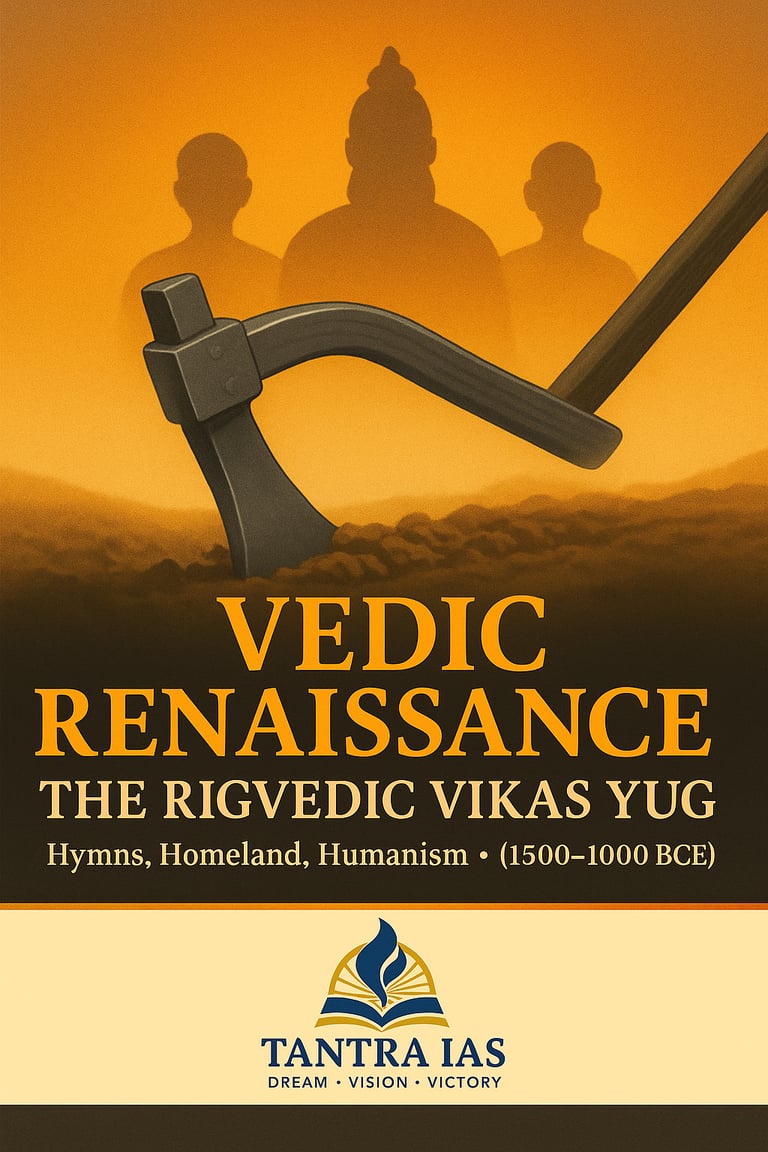

“VEDIC RENAISSANCE: THE RIGVEDIC VIKAS YUG”
From Nomads to Nation-Builders — India’s First ‘Amrit Kaal of Ideas’ (1500–1000 BCE)
Sapta Sindhu: No cities, no maps — only memory.
Their capital? Faith. Their currency? Word.
As Harappan drains fade, Rigvedic hymns rise —
the first ‘Digital India’ powered by Oral Storage.
They carried fire instead of flags, discipline instead of dynasties.
This was India’s first soft-power startup — the Rig Vedic Vikas Yug.
⚡ 10 PRECIOUS POINTERS (Prelims + Mains Aligned, 2013–2025 Trend):
1️⃣ Geographical Footprint (Prelims + GS-1 Geo-Culture)
Rigvedic world spanned Punjab & NW India (Sapta Sindhu).
→ The cradle of ‘One India – Many Rivers’.
→ Geography shaped early culture — a GS-1 favourite.
2️⃣ Political Framework – Proto Democracy
Tribal polity with Rajan assisted by Sabha & Samiti (councils).
→ Jan Bhagidari before Janata Party.
(GS-2 Governance origin + PYQs on political institutions)
3️⃣ Social Order – Fluid and Egalitarian
No rigid caste; Varna based on profession and merit.
→ Sabka Saath without Sabka Rank.
(GS-1 Society + PYQs on social mobility)
4️⃣ Economic Life – Pastoral Prosperity to Agrarian Awakening
Cattle wealth = measure of status; agriculture emerging.
→ GDP = Go-Dhan Potential.
(Prelims topic: economic life in Vedic Age)
5️⃣ Religion – Ritual without Rigidity
Nature-centric deities: Indra, Agni, Varuna; no idols, no priests’ monopoly.
→ Spiritual federalism — diversity in devotion.
(Prelims & GS-1 Culture)
6️⃣ Gender Balance – The Age of Dialogues
Gargi, Maitreyi, Lopamudra engage in philosophical debate.
→ Nari Shakti Amrit Kaal prototype.
(GS-1 Society & Women’s Status)
7️⃣ Knowledge Tradition – India’s First Oral Database
Rig Veda = 1,028 hymns of knowledge transfer via oral precision.
→ Digital Memory before Digital India.
(GS-1 Culture + Prelims literature component)
8️⃣ Ethics and Values – Seeds of Dharma
Concept of Rita (order & moral law) precedes Dharma.
→ Rule of Law without Law Books.
(GS-4 Ethics origin & GS-1 culture)
9️⃣ Art & Aesthetics – Sound as Structure
Music, poetry, and chant = creative art forms.
→ India’s first performing arts economy.
(GS-1 Art and Culture)
🔟 Civilizational Continuity – Harappan Discipline + Vedic Dynamism
Rigvedic society inherits order and adds meaning.
→ From baked bricks to burning ideas – Continuity through Change.
🪔 ONE-LINE ESSENCE
The Rigvedic Age was India’s first Viksit Bharat blueprint — where faith met freedom and hymns built harmony.
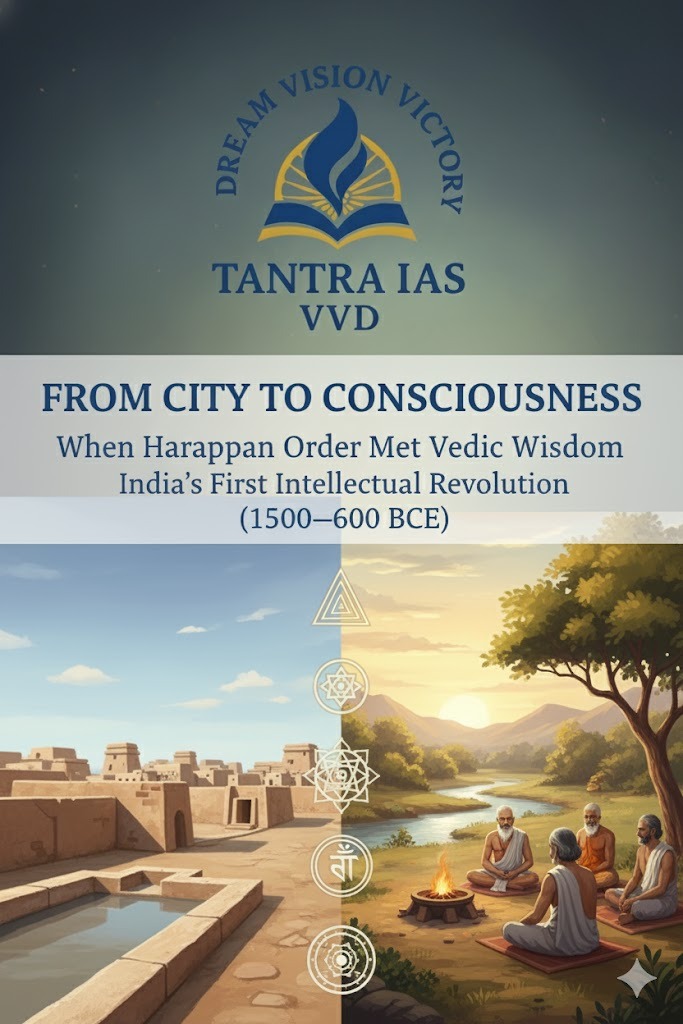

“FROM CITY TO CONSCIOUSNESS”
When Harappan Order Met Vedic Wisdom — The Birth of India’s Civilizational DNA:
“One built drains, the other built dreams.
One mastered logistics, the other mastered logic". That meeting wasn’t just history.
It was the moment India became India — where structure met spirit.
⚡ 10 PYQ-ALIGNED UPSC POINTERS:
1️⃣ The Great Synthesis (GS1 – Continuity in Civilization)
Cultural shift, not civilizational collapse — Vedic absorbed Harappan discipline.
→ No invasions, only integrations.
→ India didn’t end; it evolved.
2️⃣ From Drainage to Dharma
Harappan civic order → Vedic moral order.
→ Urban ethics became spiritual ethics.
3️⃣ City-State → Mind-State (GS2 Governance)
From physical planning to metaphysical planning.
→ Administrative grid transformed into mental grid of dharma.
4️⃣ Water Logic + Fire Logic
Harappan hydro-engineering fused with Vedic ritual fire = ecological consciousness.
→ Sustainability before sustainability was a subject.
5️⃣ Economy with Ethics (GS3 + GS4)
Material prosperity of Harappa + moral restraint of Vedas = balanced economy.
→ GDP + Gita, not GDP vs Gita.
6️⃣ Continuity of Gender Grace
From Mother Goddess to Gargi — feminine divinity to feminine intellect.
→ Shakti as both source and scholar.
7️⃣ Soft Power Begins (Essay, Culture, IR)
Vedic language carried Harappan precision outward.
→ India’s first export wasn’t spice — it was sense.
8️⃣ Scientific Temper with Soul (GS3 Science + Ethics)
Harappan science of structure + Vedic science of sound.
→ STEM meets Sanskrit.
9️⃣ Society to Civilization (GS1 Social Evolution)
Transition from uniform city-life to value-driven community-life.
→ Collective living became collective consciousness.
🔟 Blueprint for Bharat@2047 (Essay, GS2, GS4)
Harappan logic + Vedic philosophy = ideal template for modern India’s growth model.
→ Viksit Bharat = balance of structure and soul.
🪔 ONE-LINE ESSENCE
India didn’t move from bricks to books — it moved from blueprints to being.
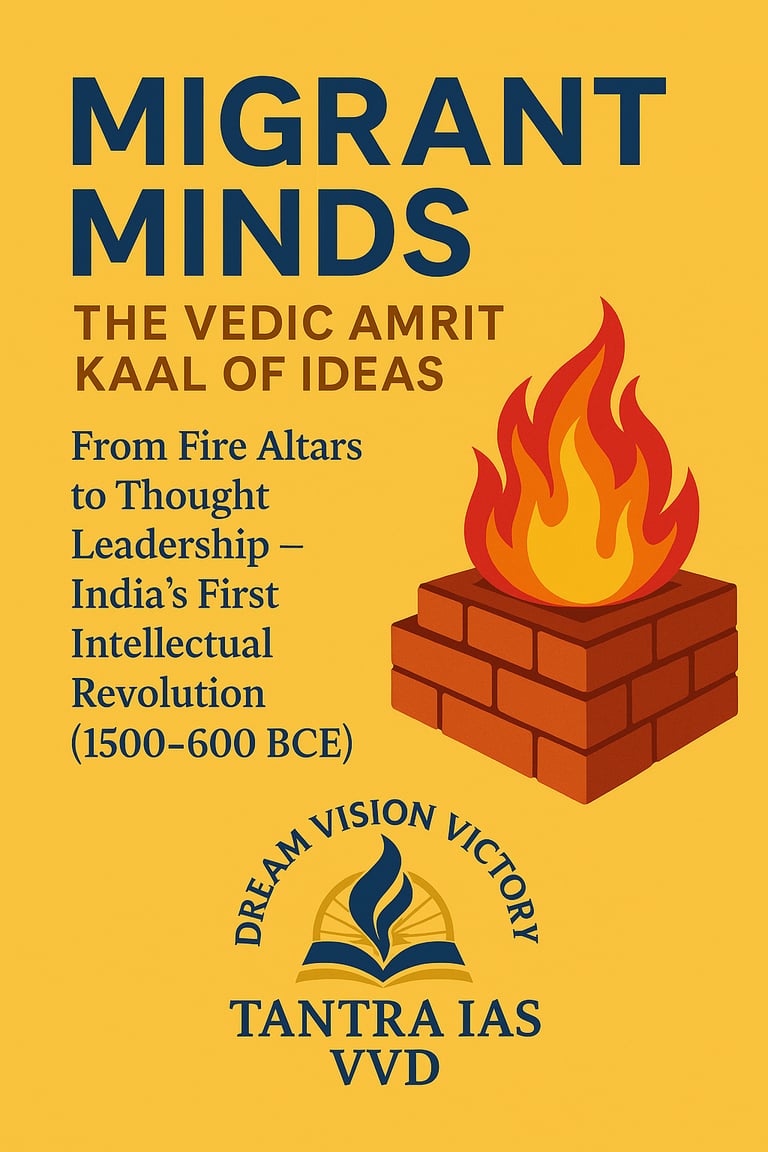

“MIGRANT MINDS | THE VEDIC AMRIT KAAL OF IDEAS”
From Fire Altars to Thought Leadership — India’s First Intellectual Revolution (1500–600 BCE)
"Dust rises over the Sapta Sindhu.
Nomads with no GPS, no Google Maps — only hymns.
Their luggage? Logic. Their passport? Sanskrit.
They carry no bricks, yet build an empire of ideas".
“When Harappa built drains, they built direction.”
The Vedic age — India’s first Think-Tank Mission.
⚡ 10 PRECIOUS POINTERS :
1️⃣ Mind over Material
Early Vedic life was pastoral, but intellectual.
→ From cow sheds to cosmic codes.
→ Economy simple; philosophy complex.
2️⃣ Rig Veda = India’s First Constitution of Thought
Ten mandalas, 1,028 hymns — order, duty, cosmos.
→ Policy drafted in poetry.
3️⃣ Sabha & Samiti = Jan Manch of Ancient India (GS2 Governance)
Tribal assemblies decided affairs collectively.
→ Panchayat Raj 0.1 — governance without gavel.
4️⃣ Gender & Grace
Women like Gargi and Maitreyi questioned metaphysics.
→ Nari Shakti before hashtags.
5️⃣ Economy Evolves (GS3 Agriculture)
From cattle wealth to iron tools — productivity ↑ prosperity ↑.
→ First Green Revolution without fertilizers.
6️⃣ Science of Sound = Technology of Transmission
Oral tradition ensured accuracy for centuries.
→ Data backup by devotion.
7️⃣ From Fire to Philosophy (UPSC Ethics Angle)
Yajna symbolized duty, not donation.
→ Sacrifice as service ethic.
8️⃣ Social Flux & Varna System (Hot Mains Topic)
Fluid in Early Vedic, hardened later — lesson in social mobility vs rigidity.
→ From fluidity to fossilization.
9️⃣ Language as Soft Power (Essay & Culture)
Sanskrit unified thought across tribes — India’s first national ID.
→ Make in Mantra, Export in Meaning.
🔟 Amrit Kaal of Ideas → Atmanirbhar Thought Economy
Vedic era = mindset shift from material progress to mental progress.
→ Innovation before infrastructure.
🪔 ONE-LINE ESSENCE:
The Vedic Age proved that India’s real GDP was its Gross Depth of Philosophy.


URBAN DHARMA:
Harappan Civilization — India’s Proto-Viksit Bharat Blueprint (2500 BCE):
No wifi. No WhatsApp. No Parliament.
Yet—every street knows its lane, every drain knows its duty.
No slogans. No manifestos. Just perfect public service delivery—
“Amrit Kaal before hashtags.”
Harappa: the civilization that achieved Good Governance without Government.
⚡ 10 PRECIOUS PEARLS FOR UPSC:
1️⃣ Urbanisation by Design
Grid-plan cities with right-angled roads and citadel zoning.
→ Governance by geometry, not genealogy.
2️⃣ Civic Welfare as Policy
Great Bath, granaries, public wells — Harappan Jal Jeevan Mission.
→ Public goods without publicity.
3️⃣ Standardisation = Proto-Bureaucracy
Uniform bricks, binary weights, regulated trade.
→ When spreadsheets were clay sheets.
4️⃣ Sanitation before Spectacle
Covered drains, soak pits, street cleaning.
→ They built Swachh Bharat before slogans were invented.
5️⃣ Maritime Diplomacy
Lothal dockyard + Mesopotamian trade = India’s first foreign policy white paper.
→ Globalisation without global summits.
6️⃣ Social Equality Signals
Similar house sizes, no palaces or temples → civic parity.
→ Sabka Ghar, Sabka Vikas — Bronze Age edition.
7️⃣ Silent Script, Loud Economy
Seals of trade, symbols of enterprise — commerce, not conquest.
→ Ease of Doing Business, 2500 BCE style.
8️⃣ Climate Shock & Resilience
Saraswati’s drying challenged sustainability.
→ India’s first Climate Adaptation Plan—made of mud, not MoUs.
9️⃣ Food Security Prototype
Granaries for surplus, redistribution for stability.
→ NFSA before the Constitution.
🔟 Harappan Ethos for Amrit Kaal
Policy as precision, leadership as layout.
→ Blueprint for today’s Smart City Mission.
🪔 ONE-LINE ESSENCE:
Harappa was India’s first model ministry — zero politics, 100 % planning.
